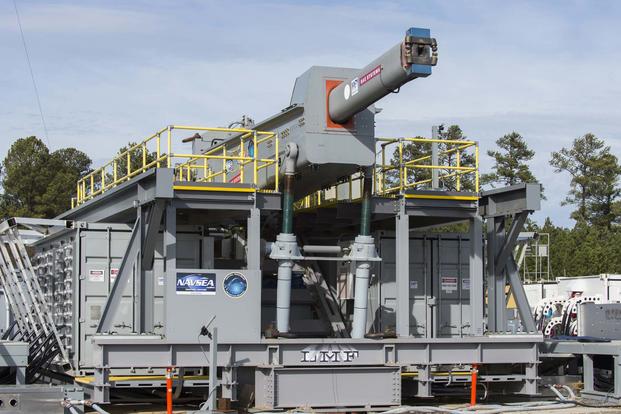Following a flurry of reports in December predicting the Navy's $500 million electromagnetic railgun experiment was dead on arrival, the chief of Naval Operations told lawmakers this week that the death of the program was greatly exaggerated.
"[We are] fully invested in railgun; we continue to test it," Adm. John Richardson told the House Appropriations subcommittee on defense during a Wednesday hearing on Navy and Marine Corps budget issues. "We've demonstrated it at lower firing rates and ... shorter ranges. Now we have to do the engineering to, sort of, crank it up and get it at the designated firing rates, at the 80- to 100-mile range."
Richardson was responding to a question from Rep. Tim Ryan, D-Ohio, who expressed concern about the proven capability of the Navy's railgun weapon, which has yet to leave its test site at Naval Surface Warfare Center Dahlgren Division, Virginia.
"My understanding is these weapons can fire projectiles at extremely high speeds with a range exceeding a hundred miles once fully operational," Ryan said. "I know China has demonstrated a capability for shipboard railguns, and I'm just concerned, again, that maybe we're falling short here."
Photos showing what appears to be a railgun mounted on the Chinese landing ship tank Haiyang Shan emerged in February. The evidence of what appears to be deployable Chinese railgun technology came to light following a handful of reports indicating the Navy's own gun development program was losing steam.
Business Insider reported in December that the Pentagon's Strategic Capabilities office was shifting research efforts from the railgun, which uses electromagnetic energy to shoot large projectiles at speeds of up to 4,500 miles per hour, to broader high-velocity projectile study.
The Navy has never acknowledged a loss of interest in railgun technology, however. Last July, officials with the Office of Naval Research told reporters that the power behind the gun would be increased to 32 megajoules over the summer, giving the weapon a range of 110 miles.
In testimony Wednesday, Richardson indicated the weapon had yet to reach that range in spite of predictions.
"That involves a number of technologies," he said. "The barrel itself is probably the limiting case, the engineering on that, the materials required to sustain that power pulse, and the heat and pressure that's involved in launching those projectiles. And we're doubling down on that."
Engineers have found the gun's barrel wears out rapidly when metal projectiles are fired at the blistering rates the railgun's technology delivers. Another unresolved issue is the power source for the gun; currently only the new three-ship Zumwalt class of class of mega-destroyers is reportedly capable of supplying the electromagnetic charge needed to operate the gun. The Navy wants to deploy a version of the railgun aboard smaller-sized destroyers.
While Richardson acknowledged the challenges and said Navy brass were "very conscious" of reported Chinese achievements in railgun technology, he maintained the service was still invested in the program.
"As a benefit, too, of the program -- the railgun program, we have developed a projectile -- high-velocity projectile, which is actually usable across the fleet in a number of different applications, not only in the railgun," Richardson said. "And so, it's a very fruitful program that we continue to invest in."
-- Hope Hodge Seck can be reached at hope.seck@military.com. Follow her on Twitter at @HopeSeck










